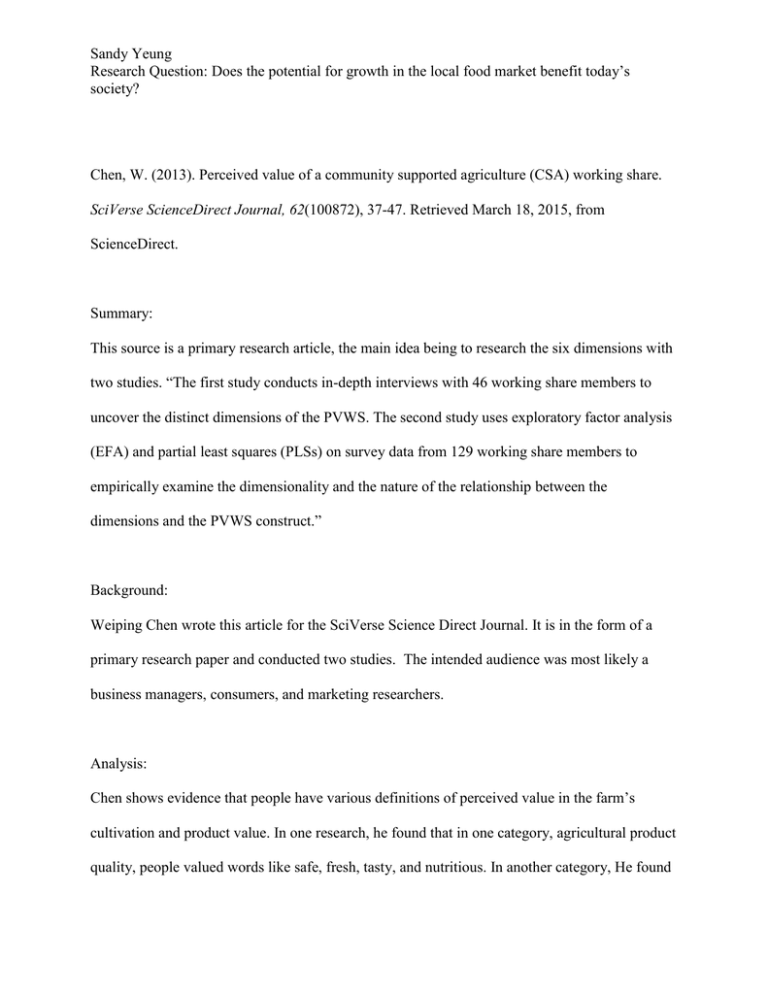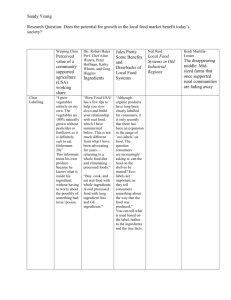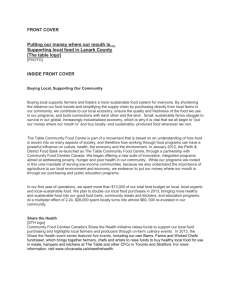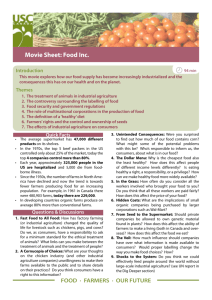Annotated Bib for UNIV 112
advertisement

Sandy Yeung Research Question: Does the potential for growth in the local food market benefit today’s society? Chen, W. (2013). Perceived value of a community supported agriculture (CSA) working share. SciVerse ScienceDirect Journal, 62(100872), 37-47. Retrieved March 18, 2015, from ScienceDirect. Summary: This source is a primary research article, the main idea being to research the six dimensions with two studies. “The first study conducts in-depth interviews with 46 working share members to uncover the distinct dimensions of the PVWS. The second study uses exploratory factor analysis (EFA) and partial least squares (PLSs) on survey data from 129 working share members to empirically examine the dimensionality and the nature of the relationship between the dimensions and the PVWS construct.” Background: Weiping Chen wrote this article for the SciVerse Science Direct Journal. It is in the form of a primary research paper and conducted two studies. The intended audience was most likely a business managers, consumers, and marketing researchers. Analysis: Chen shows evidence that people have various definitions of perceived value in the farm’s cultivation and product value. In one research, he found that in one category, agricultural product quality, people valued words like safe, fresh, tasty, and nutritious. In another category, He found Sandy Yeung Research Question: Does the potential for growth in the local food market benefit today’s society? that Health value, the perceived value includes a peaceful environment, fresh air and exercise. Thus, Participants continuously obtain high- quality food as a result of growing their own food. Informant 5 quoted, “We feel that the commercial vegetable do not taste the same and do not have the same nutritional value as our home grown ones. If all vegetables produce was produced in this way we would be willing to pay higher prices”. Based on the finding, there seem to be a high pride in “the original taste of vegetables” and often looks at past rather than what we have now known as industrial food- processing. Sandy Yeung Research Question: Does the potential for growth in the local food market benefit today’s society? Ingredients. Dir. Robert Bates. Perf. Chef Alice Waters, Peter Hoffman, Kathy Whims, and Greg Higgins. Optic Nerve Production, 2009. Documentary. Summary: The purpose of this documentary was discuss particularly the American food system. Ingredients explores the crisis of the today’s industrial food. This article presents evidence from several previous experience and findings from the kitchens of several chefs to the farms of Willamette Valleys. Background: The director and the casting crew of this documentary are Robert Bates. This source is a secondary research source because it provides an interpretation of information from other authors. In efforts to have done this work, the audience captured are the general public including in the interest of improving the health of his children and the environment. Robert Bates main purpose or goal with Ingredients is to “attempt to witness and reflect the work of individuals who are tirelessly devoted to producing food with the intention of feeding people, and not just turning the wheel of commerce.” Analysis: Sandy Yeung Research Question: Does the potential for growth in the local food market benefit today’s society? The documentary address eye- catching truth about the unhealthy fats and high fructose Corn syrup. Unfortunately, “cheap food contains cheap and toxic ingredients... and you get what you pay for”. Not only are cheap food toxic, they also include hidden costs that you may not know about, this are category like subsides, foodborne illnesses, chronic disease, environment, and energy. There are indeed struggles with local farmers as well, in the perspective of real- life farmers in the documentary, land are disappearing at an alarming rate, “about one million acres per year”. Even with the support of organizations of CSA (community supported agriculture) relieving some pressure f farmers’ operational cost, farmers are steeply declining. Sandy Yeung Research Question: Does the potential for growth in the local food market benefit today’s society? Pretty, J. (2001, November 2). Some Benefits and Drawbacks of Local Food Systems. Retrieved March 18, 2015, from http://www.sustainweb.org/pdf/afn_m1_p2.pdf Summary: This source is a primary source that explores the connection about agricultural food. The intended audience are the other authors, researchers, and consumer- producer groups. This article purpose is also to inform the general public as well because he deeply explains that “the modern agricultural revolution contains the seeds of its own destruction”. He makes a compelling argument as he compares the results from fifty years ago. Over time, the value of food has changed and the systems that produce that food “damages the environment and the community” Background: Jules Pretty is currently the Professor of Environment and Society at University of Essex. Jules latest book, The Edge of Extinction, was published by Cornell University Press. This piece explores the importance the little nature left on earth and nature. His research is focus on the well-being of the environment and agricultural sustainability. Sandy Yeung Research Question: Does the potential for growth in the local food market benefit today’s society? Analysis: Naturally, the food that is supposed to sustain us is changing into an industrialized world. There is a new form of trust and understanding, leading to a new construction of food. Indeed there are benefits and drawbacks on the local food systems. Some benefits include the firstly the farmers’ groups where individuals can cross a new frontier together. This creates a new value in the agricultural systems and values because there’s more ways to increase awareness on “real food”. Another advantage of the local authorizes can offer support from local farmers, increase green spaces, and conserve a diversity of distinctive food. A set back is the slow food moment, concerns over the fast food companies. The production of “real food” takes skill and development and though it can some convince restaurants, fast food restaurants include a rapid way of spreading homogenization. Sandy Yeung Research Question: Does the potential for growth in the local food market benefit today’s society? Reid, N. (2012). Local Food Systems in Old Industrial Regions (p. 286). Indiana: Ashgate Publishing Group. Summary: The purpose of this article was to discover correlations between “local food systems” and “old industrial regions” (243). The intended audience are of interest in “local food systems-among policy makers, planners, and public health professionals, as well as environmentalists, community developers, academics, farmers, and ordinary citizens.” In order to accomplish this, he looks at numerous topic including urban farming, extreme environments, “understanding the narrative of hunger in the United states” and in other places such as Canada. Background: Neil Reid is a professor of Geography and Planning at the University of Toledo and currently a Director of the Urban Affairs Center. He centers on the unique challenges of local food systems and matching supply and demand. In addition, Neil continued his series in The Local Food Systems and Old Industrial Food with a best- seller book called The Dynamics of Economics Space. Analysis: The process of industrialization and globalization has changed the structure of food so how can we define local food systems? Why is it that some places [states or countries] have successful local food systems? One popular belief or definition of the word “local” is similarity focusing on Sandy Yeung Research Question: Does the potential for growth in the local food market benefit today’s society? the center of the small circle. This belief is not to said wrong in any way however it the major components of the physical and organizational structure that make up a local food system. Philadelphia is one of few major cities that can be self-described as local food system. Without the obvious components including things like “regional farms, farms stands, farmers markets and CSAs, it would not be able to be considered a local food system. Most value the insight of “real food” thus offering insights into opportunities facing the region’s food system. Sandy Yeung Research Question: Does the potential for growth in the local food market benefit today’s society? Marttila-Losure, H. (2012, July 14). The disappearing middle: Mid-sized farms that once supported rural communities are fading away. Dakotafire, 5-5. Summary: The purpose of this article was to discuss the truth of the disappearance of mid-sized family farm. The decline if farmers has affected the farmers by producing “bigger farms but fewer farmers”. The percentage of the workforce in the United States “declined from 22 percent to 2 percent from 1930 to 2002”. The problem with the fewer farmers is that not all farmers can get bigger thus, they are “forced out of agriculture”. Yet, there are every head to every tail, there are advantages as well. Background: This is a primary research article that was written by Heidi Marttila-Losure. She is an active member in Dakotafire media. After creating and managing a virtual new room for newspaper journalist, she has edited story all the region. The intended audience is mainly for people in Dakota state and since it is online, the ordinary citizens. This issue may also be for the policymakers and people in head [boss] local farmers. Analysis: Sandy Yeung Research Question: Does the potential for growth in the local food market benefit today’s society? In order to provide evidence for their claim, Heidi Marttila-Losure examined historical views on low- wage earners, community decline, problems with, and several other potentially negative effects of having a farm including weather conditions and distribution. This article is unique because it truly looked over at two different perspective of information in relation to this subject. The sub question brings out your curiosity and how far they will go until all the farms are gone. By the looks of it, “if the current trends continue, most if these farms will be gone in 10 years”, how will be obtain food and what will be of this earth?






